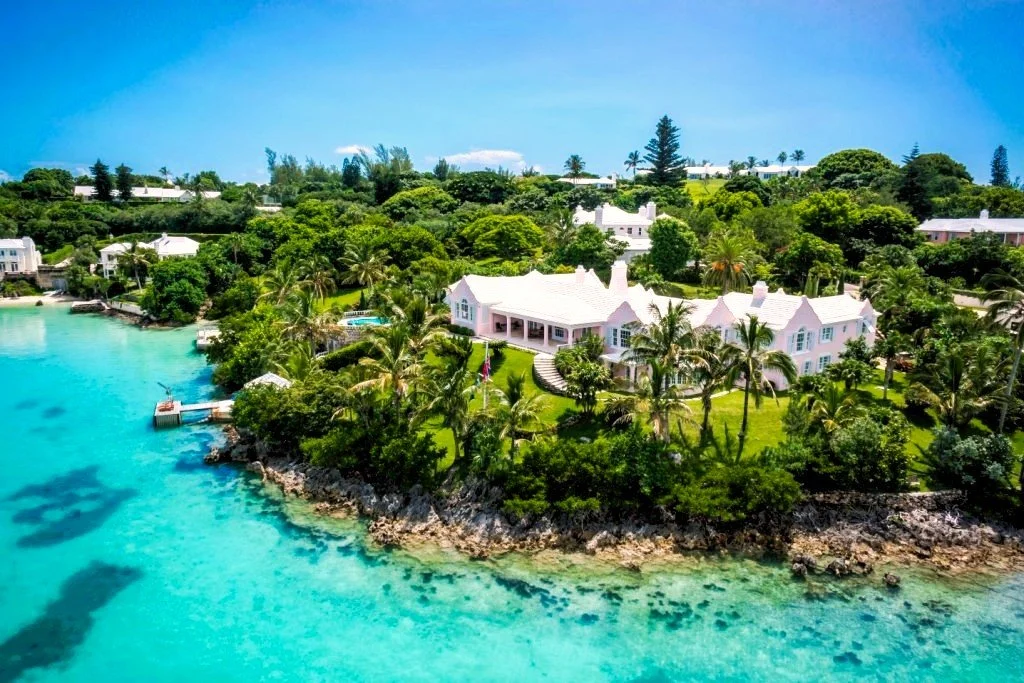Bermuda, the Islands of the "Devil", North Altantic Ocean
Isles of Light and Whispering Waves
The Mid-Ocean Club, Tucker’s Town, Bermuda — a haven of emerald greens and ocean vistas.
Bermuda revealed itself in fleeting glimpses: green islands embraced by waters shifting from emerald to turquoise, blue to grey, and beaches tinged a delicate pink. The fish-shaped land seemed both tropical and temperate, a curious blend of Caribbean ease and British formality.
Along Hamilton’s Front Street, passengers from a recently docked cruise ship wandered, spilling from shops with treasures in hand. “I bought a splendid Irish jumper,” said a plump American lady, her three shopping bags ballooning like overfilled balloons, nearly colliding with me. Nearby, a policeman stood in the Bird Cage, directing tourists with quiet authority, a living emblem of the island’s orderly charm.
Trimingham was a famous department store in Hamilton, Bermuda, established in 1842.
Dark clouds gathered swiftly. The first raindrops fell. Here, weather is no trifling matter. Locals, seasoned by sudden squalls, hurried for shelter, while I turned towards my car and the narrow road leading to our villa perched on the rocks above the restless Atlantic.
In August 2024, Ernesto roared across Bermuda, a tempest stirring wind and sea.
I thought of Shakespeare’s The Tempest. In Elizabethan times, Bermuda was whispered to be a haunted isle. Ships bound for America were dashed on reefs now lauded for their beauty, and Juan de Bermúdez fled in 1503, convinced he had glimpsed the Devil’s domain. All he left behind was his name.
Blush and green — sea and sky, Bermuda’s enduring beauty.
The road to Tucker’s Point wound along Harrington Sound, where foliage brushed quiet inlets and small sailing boats rested beside whitewashed houses. From the aeroplane, I had admired the kaleidoscope below: emerald waters folding into turquoise bays, rooftops peeking through dense greenery, beaches blushing soft pink. The land was intimate yet grand, each tiny island a secret framed by sea.
Most visitors ignored this spectacle, their eyes fixed on the weather, praying it would hold for golf. Seven courses on an island fifteen miles long and scarcely two and a half miles wide seemed their only concern. I watched the skies too, but with the eye of a traveller, attuned to light, movement, and the whispering mood of sea and wind.
Pink house embraced by turquoise and emerald.
“The island is strange,” I thought, descending the narrow lane to our villa. “It never snows, never grows cold, yet palms flourish as if in the tropics.” Minutes later, I stood behind the great living-room windows, mesmerised. The storm broke over steep rocks, waves smashing the cliffs, wind stirring the Atlantic into silver frenzy. Here was Bermuda: calm and tempestuous, orderly and wild, a theatre of light and water, of colour and sound, where each glance at sea or sky became a revelation.
*I recall that my visit occurred in the early 1980s. I was saddened to learn that Triminghams, founded in 1842 and once the repository of British treasures, closed in 2006. Its family home now serves as the headquarters of the Bermuda National Trust.
Travel with my Books in English





